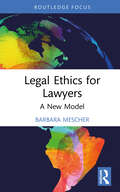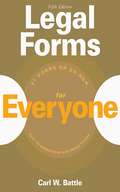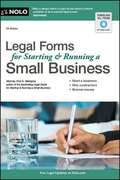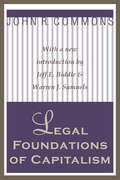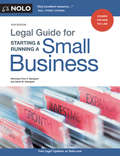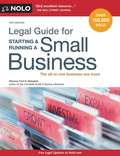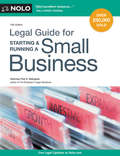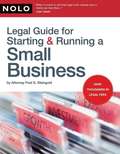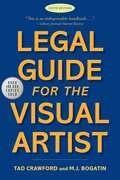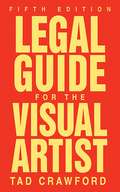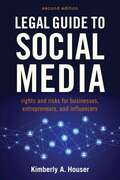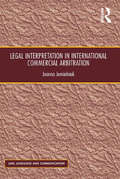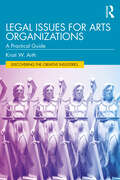- Table View
- List View
Legal Effects of Fluctuating Exchange Rates
by Joseph GoldA report from the International Monetary Fund.
Legal Environment
by Jeffrey F. Beatty Susan S. Samuelson Patricia Sánchez AbrilDiscover the business law text you'll actually enjoy reading. Time after time, students like you have commented that this is the best text they have ever read and they had no idea law could be so interesting. The student choice every time, LEGAL ENVIRONMENT, 7E is packed with current examples and real scenarios that bring law to life for today's business student. Extremely reader-friendly, this engaging presentation uses conversational writing to explain complex topics in easy-to-understand language. Memorable real-world stories help the authors illustrate how legal concepts apply to everyday business practice. This edition emphasizes the digital landscape with new information on privacy and intellectual property. An updated ethics chapter offers a practical approach, using the latest research to explain why people make unethical decisions.
Legal Environment Of Business: A Managerial Approach: Theory To Practice
by Sean Melvin Enrique Guerra-PujolLegal Environment of Business, A Managerial Approach: Theory to Practice emphasizes bridging the gap between understanding legal doctrines that impact the business environment and how business owners and managers use legal insight to limit liability and manage risk. Its distinct approach focuses on using teaching features, simulations, case studies, examples, and case law that is accessible and engaging because it is specifically tailored for business students.
Legal Ethics for Lawyers: A New Model (Routledge Research in Legal Philosophy)
by Barbara MescherThis book proposes a new model of professional ethics enabling lawyers to advise clients upon both the law and ethics. This will better protect clients, and society, and enhance lawyers’ professional obligations. The current model of legal ethics, developed in the 19th century, specified that the role of lawyers was only to interpret the law, not also to give ethical advice. This was acceptable to lawyers, clients, and society at that time. However, this is not the case now and legal ethics no longer reflects the needs of modern legal practice. This book draws on moral philosophy to present a new model of legal ethics that explains the analytical process to include ethical advice. It analyses the potential harm of the present model to the legal profession who have duties to the law and justice that may compete with demands by clients to serve them. Further, lawyers’ duty to clients to act in their best interests is sometimes not adequately fulfilled as legal ethics does not permit lawyers to give ethical advice even if it may be in clients’ best interests to do so. The work includes a detailed case study of corporate law practice to show why a new legal ethics is required. Other case examples are provided to demonstrate that lawyers practicing in all areas of law encounter ethical issues and they too will benefit from a new legal ethics. The book will be essential reading for students, academics, lawyers and professional bodies.
Legal Forms for Everyone (Legal Forms For Everyone Ser.)
by Carl BattleRenting an apartment? Buying your first home? Thinking about a will? Legal Forms for Everyone is the ultimate self-help legal guide that will save you hours of research time and money in legal fees. Written by an experienced attorney, this book is complete with the most commonly needed, ready-to-use legal forms and precise instructions on how to use them. Also included is advice about when you should hire an attorney. You will also find handy checklists included on the CD-ROM. Easy to understand and ready to use!
Legal Forms for Everyone: Leases, Home Sales, Avoiding Probate, Living Wills, Trusts, Divorce, Copyrights, and Much More (Legal Forms For Everyone Ser.)
by Carl BattleLegal Forms for Everyone is the ultimate self-help legal guide that will save hours of research time and money in legal fees. Written by an experienced attorney, this book is complete with the most commonly needed, ready-to-use legal forms and precise instructions and checklists on how to use them, as well as advice about when you should hire an attorney. In addition, all the forms are online on a supplemental website to aid in customizing for individual needs. Readers will find forms and advice for a variety of legal situations, including preparing a will, avoiding probate, buying and selling real estate, handling divorce or separation, getting a new name, copyrights and trademarks, bankruptcy, and so much more. However, due to the ever-evolving legal system and the development of new technologies, Carl Battle has added to this new edition such changes as:How to protect against credit fraud, identity theft, and internet fraudHow to navigate new electronic filing systems for copyrights, trademarks, and patentsUpdated information in filing fees, exemptions, and forms for filing for bankruptcyThe latest information on filing for patentsLegal Forms for Everyone is a comprehensive tool for getting in and out of legal situations without having to pay for that costly attorney.
Legal Forms for Everyone: Wills, Probate, Trusts, Leases, Home Sales, Divorce, Contracts, Bankruptcy, Social Security, Patents, Copyrights, and More
by Carl W. Battle Andrea D. Small&“Reproducible, ready-to-use forms are accompanied by step-by-step descriptions of the process involved in over twenty common legal issues. … Well designed and easy to use.&” —American LibrariesLegal Forms for Everyone is the ultimate self-help legal guide to saving research time and money in legal fees. Written by two experienced attorneys, this book is complete with the most commonly needed, ready-to-use legal forms, along with precise instructions and checklists on how and when to use them––and advice for when you should hire an attorney. The forms are also available from a supplemental website to directly download to your device and customize for your individual needs. Legal situations covered include preparing a will, avoiding probate, buying and selling real estate, handling divorce or formal separation, getting a new name, copyrights and trademarks, bankruptcy, and much more. Due to the ever-evolving legal system and technological developments, this seventh edition features new sections covering the following topics: How to apply for a passport, including advice on compiling evidence of citizenship How to apply for and claim Social Security benefits How timing of retirement can effect Social Security retirement benefits How to get a certified copy of a birth or death certificate, including state-by-state advice Assigning a medical proxy Legal Forms for Everyone is a comprehensive tool for assistance with legal situations without having to pay for a costly attorney.
Legal Forms for Starting & Running a Small Business
by Fred S. SteingoldMost small business owners, can't afford to hire a lawyer to draft the legal documents they need in the course of day-to-day business. Now there's an affordable solution. Legal Forms for Starting & Running a Small Business provides over 60 legal forms and documents and all the step-by-step instructions needed to use them. This collection of essential legal and business documents helps you: . create contracts to buy, sell, rent, or store goods . hire employees and consultants . protect your trade secrets . create noncompete agreements . prepare an LLC operating agreement . borrow and lend money . buy a business . lease commercial space . prepare corporate bylaws . record minutes of meetings . buy real estate . and much more This edition is updated with the latest legal documents, contracts, and other forms you need to run your business smoothly, along with up-to-date best practices for business owners and managers. Legal Forms for Starting & Running a Small Business includes all the information and instructions you need to complete and use your forms effectively.
Legal Forms for Starting & Running a Small Business
by Fred S. SteingoldMost small business owners, can't afford to hire a lawyer to draft the legal documents they need in the course of day-to-day business. Now there's an affordable solution. Legal Forms for Starting & Running a Small Business provides over 60 legal forms and documents and all the step-by-step instructions needed to use them. This collection of essential legal and business documents helps you: create contracts to buy, sell, rent, or store goods hire employees and consultants protect your trade secrets create noncompete agreements prepare an LLC operating agreement borrow and lend money buy a business lease commercial space prepare corporate bylaws record minutes of meetings buy real estate, and and much more. This edition is updated with the latest legal documents, contracts, and other forms you need to run your business smoothly, along with up-to-date best practices for business owners and managers. Legal Forms for Starting & Running a Small Business includes all the information and instructions you need to complete and use your forms effectively.
Legal Forms for Starting & Running a Small Business
by Fred S. Steingold AttorneyLike most small business owners, you probably can't afford to hire a lawyer to draft the legal documents you need in the course of your day-to-day business. Now there's an affordable solution. , Legal Forms for Starting & Running a Small Business, provides you with over 60 legal forms and documents and all the step-by-step instructions you need to use them. This collection of essential legal and business documents helps you: * create contracts to buy, sell, rent, or store goods * hire employees and consultants * protect your trade secrets * create noncompete agreements * prepare an LLC operating agreement * borrow and lend money * buy a business * lease commercial space * prepare corporate bylaws * record minutes of meetings * buy real estate * and much more This edition is updated with the latest legal documents, contracts, and other forms you need to run your business smoothly, along with up-to-date best practices for business owners and managers. Plus, , Legal Forms for Starting & Running a Small Business, includes all the information and instructions you need to complete and use your forms effectively.
Legal Forms for Starting & Running a Small Business: 65 Essential Agreements, Contracts, Leases & Letters
by Fred S. SteingoldMost small business owners, can't afford to hire a lawyer to draft the legal documents they need in the course of day-to-day business. Now there's an affordable solution. Legal Forms for Starting & Running a Small Business provides more than 70 legal forms and documents and all the step-by-step instructions needed to use them. This collection of essential legal and business documents helps you: create contracts to buy, sell, rent, or store goods hire employees and consultants prepare an LLC operating agreement prepare corporate bylaws buy a business borrow and lend money protect your trade secrets create noncompete agreements lease commercial space record minutes of meetings buy real estate and much more This edition is updated with the latest legal documents, contracts, and other forms you need to run your business smoothly, along with up-to-date best practices for business owners and managers. Legal Forms for Starting & Running a Small Business includes all the information and instructions you need to complete and use your forms effectively.
Legal Forms of Organization
by Michael J. RobertsDescribes the various legal forms of organization including proprietorships, partnerships, limited partnerships, corporations, and limited liability companies. Explains the tax and liability attributes of each form, as well as other issues, which may influence the choice of legal form.
Legal Foundations of Capitalism (Reprints Of Economic Classics Ser.)
by John R. CommonsIn what has universally been recognized as a classic of institutional economics, John R. Commons combined the skills of a professional economist, the sensibilities of an American historian, and the passion of an active participant in the conflicts of individuals, self-interest of groups, and function of voluntary associations.The aim of this volume is to work out an evolutionary and behavioral theory of value. In order to do so thoroughly, Commons examines the decisions of the courts. Doing so compelled an examination of what the courts mean by reasonable value. Commons found that the answer was tied up with a notion of reasonable conduct. It was Commons who carried the study of the habits and customs of social life to the next stage: the decisions of the courts that are based on custom and that profoundly impact the nature and function of the economic system as such.Reviewing Legal Foundations of Capitalism, Wesley Mitchell declared that Commons carried this "analysis further along his chosen line than any of his predecessors. Into our knowledge of capitalism he has incorporated a great body of new materials which no one else has used adequately." And writing in the same American Economic Review twenty-one years later, Selig Perlman noted that "To Commons the workingmen were not abstract building blocks out of which a favored deity called History was to shape the architecture of the new society, but concrete beings with legitimate ambitions for a higher standard of living and for more dignity in their lives." This edition is graced with a special introduction that places Commons in proper academic as well as intellectual context.
Legal Geographies of Water: The Spaces, Places and Narratives of Human-Water Relations (Earthscan Water Text)
by Cristy ClarkThis book deepens our understanding of humanity’s diverse relationships with water and the law, providing a critical assessment of this relationship, and charting the course towards a more sustainable and just water future.By using legal geography, this book pays particular attention to the place-based inter-relationships between water, people, and law (both formal and informal) and to the ways that law both constitutes and is constituted by the relationship between people and place. Starting in the 1980s, Chapter 2 investigates the early commodification of water through the liberalisation of rural water markets in Chile and the urban water supply and sanitation systems of England and Wales. Chapter 3 then examines the global expansion of neoliberal water governance in the 1990s, starting with donor-driven reforms in the global south and particularly Manila in the Philippines. Chapters 4 and 5 document both the grassroots response to these neoliberal water reforms and the inherent tensions in the attempts of the early 2000s to reconcile the recognition of a human right to water with the ongoing rollout of market mechanisms, both in the domestic context of South Africa and within the United Nations human rights system. Moving forward again, Chapter 6 examines the recent intensification of neoliberal water governance through financialisation and considers its specific impacts in Detroit and Flint, Michigan. Chapter 7 then considers the renewed global emphasis on living waters and Indigenous ontologies of water by examining the new legislative arrangements for the Whanganui River in Aotearoa, New Zealand. The book concludes in Chapter 8 by highlighting the stories of hope that can be found in many of the case studies explored in the book and in emerging examples from around the world.This book is essential reading for students and scholars interested in water law, security, and justice from across a wide range of disciplines, including environmental studies, law, geography, human rights, and political ecology.
Legal Guide for Starting & Running a Small Business
by Fred S. Steingold David SteingoldThe all-in-one business law book Whether you’re just starting a small business, or your business is already up and running, legal questions crop up on an almost daily basis. Ignoring them can threaten your enterprise—but hiring a lawyer to help with routine issues can devastate the bottom line. The Legal Guide for Starting & Running a Small Business has helped more than a quarter million entrepreneurs and business owners master the basics, including how to: raise start-up money decide between an LLC or other business structure save on business taxes get licenses and permits choose the right insurance negotiate contracts and leases avoid problems if you’re buying a franchise hire and manage employees and independent contractors attract and keep customers (and get paid on time), and limit your liability and protect your personal assets. The 16th edition is completely updated with the latest business tax rules and numbers, and best practices for classifying workers (as employee or independent contractor).
Legal Guide for Starting & Running a Small Business
by Fred S. SteingoldSmall business owners are regularly confronted by a bewildering array of legal questions and problems. Ignoring them can lead to disaster but with lawyers typically charging $200 $300 an hour, calling one to answer routine legal questions can be a fast track to the poorhouse. Fortunately, you have a better alternative. Legal Guide for Starting & Running a Small Business clearly explains the practical and legal information you need to: . raise start up money . choose between a sole proprietorship, partnership or LLC . get licenses and permits . buy or sell a business or franchise . negotiate a favorable lease . insure your business . hire independent contractors safely . understand small business tax rules . pick and protect a good name . resolve legal disputes . adopt the best customer policies . enter into strong contracts . cope with financial problems This edition is thoroughly updated, including the latest regulations, tax numbers, and business realities in a changing economy.
Legal Guide for Starting & Running a Small Business
by Fred S. SteingoldThe all-in-one business law book! When you run a small business, legal questions crop up almost on a daily basis. Ignoring them can threaten your enterprise—but hiring a lawyer to help with routine issues can devastate the bottom line. Fortunately, you have a better alternative. Legal Guide for Starting & Running a Small Business clearly explains how to: raise start-up money pick the right business structure get licenses and permits negotiate a favorable lease protect yourself with the right insurance create binding contracts hire, fire, and manage employees cope with financial problems protect your personal assets, and save on business taxes. The 15th edition is completely updated with the latest business tax rules and numbers, including options for members of husband and wife LLCs, rules for depreciating and expensing business assets, and best practices for classifying workers (as employee or independent contractor).
Legal Guide for Starting and Running a Small Business (10th edition)
by Fred SteingoldThis easy-to-understand book covers what small-business owners need to know, such as choosing a business structure, taxes and the IRS, employees and independent contractors, and much more.
Legal Guide for the Visual Artist
by Tad Crawford M. J. BogatinAn updated edition of the legal art classic. Legal Guide for the Visual Artist is a classic guide for artists. This sixth edition is completely revised and updated to provide an in-depth view of the legal issues facing the visual artist today and provides practical legal guidance for any visual artist involved with creative work. It has been over twelve years since the fifth edition was published, and so much has changed in the world since that time, especially in the law and artists&’ legal rights and obligations. This edition has been updated for both a new generation of visual artists and for those who have purchased earlier editions. Among the many new topics covered in this comprehensive guide are: copyright fair use transformative rights; recognition of the rights of temporal street art in the Five Pointz VARA case; the demise of California&’s Resale Royalty statute; NFTs; detailed coverage of the myriad developments in copyright (including online copyright registration procedures and use of art on the Internet); changes in laws protecting artists in artist-gallery relationships are explained in depth; scope of First Amendment protections for graffiti art and the sale of art in public spaces; detailed as well as new cases dealing with art and privacy; and a model contract for Web site design and much more. The book also covers copyrights, moral rights, contracts, licensing, sales, special risks and protections for art and artists, book publishing, video and multimedia works, leases, taxation, estate planning, museums, collecting, grants, and how to find the best professional advisers and attorneys. In addition, the book suggests basic strategies for negotiation, gives information to help with further action, contains many sample legal forms and contracts, and shows how to locate artists' groups and Volunteer Lawyers for the Arts organizations. Legal Guide for the Visual Artist is a must-have for any visual artist hoping to share, sell, display, or publish their art.
Legal Guide for the Visual Artist
by Tad CrawfordThis classic guide for artists is completely revised and updated to provide an in-depth view of the legal issues facing the visual artist today and provides practical legal guidance for any visual artist involved with creative work. Among the many new topics covered in this comprehensive guide are: detailed coverage of the myriad developments in copyright (including online copyright registration procedures and use of art on the Internet); changes in laws protecting artists in artist-gallery relationships are explained in depth; scope of First Amendment protections for graffiti art and the sale of art in public spaces; detailed as well as new cases dealing with art and privacy; and a model contract for Web site design and much more. The book also covers copyrights, moral rights, contracts, licensing, sales, special risks and protections for art and artists, book publishing, video and multimedia works, leases, taxation, estate planning, museums, collecting, grants, and how to find the best professional advisers and attorneys. In addition, the book suggests basic strategies for negotiation, gives information to help with further action, contains many sample legal forms and contracts, and shows how to locate artists' groups and Volunteer Lawyers for the Arts organizations.
Legal Guide to Social Media, Second Edition: Rights and Risks for Businesses, Entrepreneurs, and Influencers
by Kimberly A. HouserLearn how to navigate the ins and outs of the law and social media. How should you respond to a request to remove copyrighted materials from a Facebook page? If you create a Twitter username at work, who owns the username when you change jobs? Can you be sued for libel if someone thinks your posts are defamatory? If you&’ve ever asked yourself these kinds of questions, this pioneering legal handbook is for you. Despite the enormous growth in social media usage by businesses and influencers, very little has been written about the laws affecting their activities. In this new edition of the Legal Guide to Social Media, Kimberly A. Houser, law professor and tech attorney, explains the potential pitfalls and how to avoid them including what social media influencers could have done to protect themselves from the lawsuits resulting from the Fyre Festival debacle. Easy-to-understand, comprehensive, and up-to-date, the Legal Guide to Social Media, Second Edition provides the latest information on case law and statutes. It covers everything from privacy laws to the legal considerations in setting up a page or website as well as new governmental regulations. This plain English legal companion offers examples of and solutions to the kinds of situations you can expect to encounter when posting online content, whether for yourself, your own business, or on behalf of your client&’s business. You&’ll learn how to avoid liability for defamation and third-party posts, how to protect your own content, the unique legal issues surrounding social media in the workplace, and much, much more. The new edition covers new state regulations on privacy, data security and advertising; how to avoid intellectual property infringement actions; and the newer legal risks for influencers.
Legal Hazards of Product Launches
by Lena G. Goldberg Annelena LobbThis note considers common legal pitfalls associated with the launch of new products. A series of questions are presented that companies poised to launch a product should keep in mind. Questions about advertising, pricing, and branding are explored, as well as who in a product's supply chain might bear liability if the product is faulty.
Legal Hazards of Product Launches
by Lena G. Goldberg Annelena LobbThis note considers common legal pitfalls associated with the launch of new products. A series of questions are presented that companies poised to launch a product should keep in mind. Questions about advertising, pricing, and branding are explored, as well as who in a product's supply chain might bear liability if the product is faulty.
Legal Interpretation in International Commercial Arbitration (Law, Language and Communication)
by Joanna JemielniakThis book fills a gap in legal academic study and practice in International Commercial Arbitration (ICA) by offering an in-depth analysis on legal discourse and interpretation. Written by a specialist in international business law, arbitration and legal theory, it examines the discursive framework of arbitral proceedings, through an exploration of the unique status of arbitration as a legal and semiotic phenomenon. Historical and contemporary aspects of legal discourse and interpretation are considered, as well as developments in the field of discourse analysis in ICA. A section is devoted to institutional and structural determinants of legal discourse in ICA in which ad hoc and institutional forms are examined. The book also deals with functional aspects of legal interpretation in arbitral discourse, focusing on interpretative standards, methods and considerations in decision-making in ICA. The comparative examinations of existing legal framework and case law reflect the international nature of the subject and the book will be of value to both academic and professional readers.
Legal Issues for Arts Organizations: A Practical Guide (Discovering the Creative Industries)
by Kristi W. ArthLegal issues touch every aspect of organizations in the creative and cultural sectors. This book teaches non-lawyer, arts administration professionals and students how to identify and manage legal issues common to arts organizations.Legal Issues for Arts Organizations demystifies common legal problems and helps readers to approach them proactively. With an easy-to-remember “issue-spotting” process, the book helps develop the average administrator’s “eye” for legal issues, so that the administrator knows when to do more research and when to seek out professional legal assistance. Written by a law professor and former intellectual property litigator with experience in arts policy and administration, this book provides a framework that arts professionals can use to navigate legal issues with increased confidence. It provides an overview of the American legal system, teaches a systematic process for identifying legal issues, trains administrators to read and understand contracts, gives practical advice for working with professional lawyers, and puts theory into practice with an applied learning component.Packed with practical tips and advice, this book provides a primer that every arts administrator and every arts- and nonprofit-management student will find immediately useful.A book adoption gift containing teaching support materials is available to instructors. To gain access, visit www.routledge.com/9780367771133.



